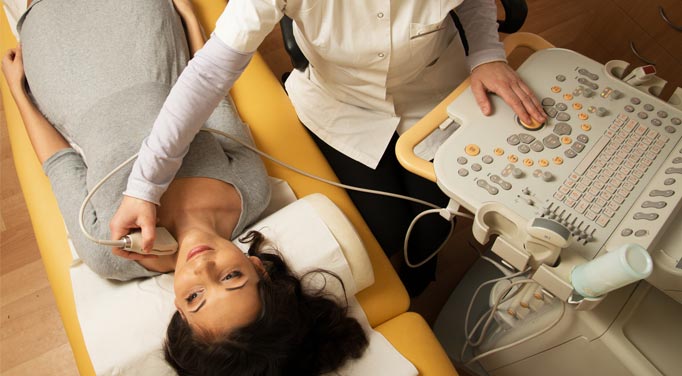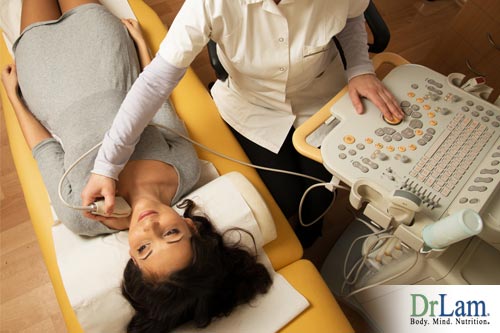 More than 10 million Americans have been diagnosed with thyroid disease, and another 13 million people are estimated to have undiagnosed Hypothyroid problems. About 10 percent of the adult population is afflicted with this frequently overlooked disease of epidemic proportion. A dysfunctional thyroid can affect almost every aspect of health. It is one of the most under-diagnosed hormonal imbalances of aging, together with estrogen dominance and syndrome X.
More than 10 million Americans have been diagnosed with thyroid disease, and another 13 million people are estimated to have undiagnosed Hypothyroid problems. About 10 percent of the adult population is afflicted with this frequently overlooked disease of epidemic proportion. A dysfunctional thyroid can affect almost every aspect of health. It is one of the most under-diagnosed hormonal imbalances of aging, together with estrogen dominance and syndrome X.
Thyroid is a small butterfly-shaped gland that wraps around the windpipe. The cells inside the thyroid takes in the iodine, obtained through food, iodized salt, or supplements, and combines that iodine with the amino acid tyrosine. The thyroid then converts this into the thyroid hormones called T3 and T4.
Once released by the thyroid, the T3 and T4 travel through the bloodstream. Under normal conditions, 80 percent of thyroid hormones are in the form of T4 and 20 percent in the form of T3. T3 is the biologically more active and is several times stronger than T4. The conversion of T4 to T3 takes place both inside the thyroid as well as in some organs other than the thyroid, including the hypothalamus, a part of your brain.
The thyroid gland acts like the body's barometer. Its main function is to help cells convert oxygen and calories into energy. It regulates:
Thyroid, like other hormones, is regulated by an extensive negative feedback system. The system starts in the hypothalamus of the brain that releases Thyrotropin-releasing Hormone (TRH). TRH signals the pituitary gland to release Thyroid Stimulating Hormone (TSH). TSH in turn instructs the thyroid gland to make thyroid hormones and release them into the bloodstream. When the level of thyroid hormone in your body is high, a negative feedback system exists to reduce the production of TSH, and vice-versa. Therefore, a high TSH is indicative of hypothyroid, while a low TSH can be indicative of hyperthyroidism.
There are varieties of factors that can contribute to the development of thyroid problems:
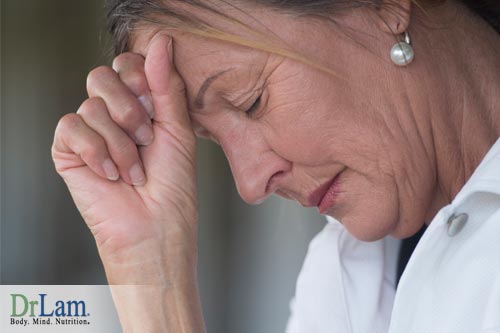 You have a higher risk of developing thyroid disease if, among a variety of factors:
You have a higher risk of developing thyroid disease if, among a variety of factors:
As many as 10 percent of 98 million Americans with high cholesterol and high LDL (bad) cholesterol may not know that their cholesterol is high due to an undiagnosed thyroid problem. Older women with sub-clinical or under-active hypothyroid is shown to be twice as likely as women without this condition to have heart attacks.
Thyroid disease is also intricately tied to adrenal gland and ovarian function.
Being one of the master regulators of body metabolism, symptoms of low thyroid are:
A popular way of diagnosing hypothyroid is using basal body temperature. Dr. Broda Barnes, M.D, popularized this test. While using basal body temperature can be better than using the standard thyroid function test, it comes with certain disadvantages, including:
Most clinicians rely on blood test instead. The traditional laboratory tests used to diagnose hypothyroid are:
Due to the complexity and inherent weakness of the traditional laboratory tests, there is widespread difficulty in their interpretation.
The key test is TSH. The lower the amount of thyroid hormone in the body, the more TSH will be produced and secreted by the pituitary to stimulate the thyroid gland to put out thyroid hormones. A low TSH signals enough TSH on board, while a high TSH signals a deficiency of TSH in the body.
For most traditional laboratories, the upper limits of normal TSH level is under 4.0 to 4.5. While those who have TSH higher than 4.5 is highly likely to have hypothyroid, many more with TSH under 4.5 have sub-clinical hypothyroid or under-active thyroid. The clinician easily misses these cases if the focus on diagnosis is based on the traditional reference range only. Many with a TSH under 4.0 are in fact symptomatic and may well be hypothyroid. In other words, the traditions normal range is far too insensitive to detect hypothyroid, especially those in the sub-clinical stage of the disease with symptoms.
The myth that an elevated TSH level (the upper limits of normal range by normal laboratory reference range is under 4.5) is required, as prerequisite for diagnosis of hypothyroid must be dispelled. There is little doubt that an elevated TSH signifies and under active thyroid as the pituitary gland secretes TSH in response to a low thyroid hormone level. The real question is - how high a TSH is considered high?
 There are doctors who believe that you do not need to have an elevated TSH level (higher than 4.5) in order to actually be diagnosed and treated for hypothyroid. Increasingly, innovative doctors are also viewing high-normal or normal TSH levels (by traditional standards) as possible evidence of low-level hypothyroid, especially if symptoms of hypothyroid are present.
There are doctors who believe that you do not need to have an elevated TSH level (higher than 4.5) in order to actually be diagnosed and treated for hypothyroid. Increasingly, innovative doctors are also viewing high-normal or normal TSH levels (by traditional standards) as possible evidence of low-level hypothyroid, especially if symptoms of hypothyroid are present.
The traditional normal laboratory range is relative. Many, especially women, have symptoms -- or are hypothyroid -- when TSH is anywhere but at the lower end of the normal range or 2 or thereabouts.
Many patients with TSH level of 2.0 (not 4.5) or more have classic symptoms and signs of hypothyroid. Even though their TSH is considered "normal" by traditional standards, many are suffering from under active thyroid or sub-clinical hypothyroid. If your routine blood work comes back with a TSH of 2.0 and you have symptoms of hypothyroid, ask your doctor! Chances are your thyroid gland is not working properly.
TSH alone, however, is not an accurate test of all forms of hypothyroid but only primary hypothyroidism. Addition tests like Free T3 (FT3) and Free T4 (FT4) are required. Some doctors also test for elevated thyroid antibodies in addition to FT3 and FT4. Many patients, especially women with elevated antibodies are in the process of developing autoimmune thyroid disease. Early detection is important to effect appropriate treatment. Even with normal TSH levels, the majority of symptomatic women with elevated antibodies, low FT3 and low FT4 require thyroid hormone replacement to feel well.
Thyroid gland produces four thyroid hormones called T1, T2, T3, and T4. The number indicates the number of iodine molecules attached to the molecule. T4 is what synthetic thyroid such as Synthroid has. T4 is a hormone precursor and is converted into T3, the form that performs most of the thyroid function in the body. Thinking that synthetic thyroid proves steady hormone levels, it is widely prescribed by doctors. Easily overlooked is the fact that many people cannot convert the T4 to T3. This is easily confirmed by measure.
Free T3 and Free T4 are the only accurate measurement of the actual active thyroid hormone levels in the body. This is the hormone that is actually free and exerting effect on the cells. These are the thyroid hormones that count.
It is common to find Free T3 and Free T4 below normal when TSH could in the normal range or in the low end of the normal range. This is indicative of secondary or tertiary hypothyroidism. This is normally thought of as due to hypothalamus or pituitary dysfunction, resulting in the body's inability to convert T4 to T3.
Ask for these tests. If your thyroid test results come back and your doctor is not sure what it means, consider going to a reputable holistic physician or alternative physician for further interpretation and diagnosis.
 Hypothyroid can be primary or secondary. Primary hypothyroid can easily be cured with administration of thyroid replacement therapy. If hypothyroid symptoms such as low body temperature, fatigue, dry skin and weight gain persist despite thyroid replacement therapy regardless of laboratory values, one must look elsewhere for the cause of low thyroid function.
Hypothyroid can be primary or secondary. Primary hypothyroid can easily be cured with administration of thyroid replacement therapy. If hypothyroid symptoms such as low body temperature, fatigue, dry skin and weight gain persist despite thyroid replacement therapy regardless of laboratory values, one must look elsewhere for the cause of low thyroid function.
Hypothyroid caused by organ malfunctions of other parts of the body other than the thyroid gland is called secondary hypothyroidism. Adrenal fatigue, for example, can trigger hypothyroid and worse existing primary hypothyroidism. The symptoms are very much similar if not identical (other than body Secondary hypothyroid is low thyroid function caused by malfunction of another organ system.
Adrenal fatigue is perhaps the most common cause of secondary low thyroid function, both clinically and sub-clinically. Low adrenal function often leads to low thyroid function, classically evidenced by high thyroid binding globulin (TBG), low free T4, low free T3, high TSH, and low body temperature. Few physicians are trained to detect this connection. Fortunately, secondary hypothyroid can be reversed when the underlying root problem (such as adrenal fatigue) is resolved. aperture and other minor signs visible to only the most astute of physicians) in the vast majority of cases.
When the adrenals are exhausted, the ability of the adrenals to handle the stress associated with normal bodily function and energy requirement is often compromised. To enhance survival, the adrenals force a down-regulation of energy production. In other words, the body is being metabolic down-regulation to slow down in order to conserve energy. The body needs to rest. Lower energy output reduces workload of the body. In times of stress, this is exactly what the body wants. As the thyroid down-regulates, T3 and thus T4 production is reduced. The down-regulation also leads to an increase in thyroid binding globulin (TBG). As a result of increased TBG, more thyroid hormones are bounded on a relative basis and less is released to the cell where it works. This lead to reduced free T4 and free T3 level in the blood if measured (while total T3 and T4 may be normal). Last but not least, cortisol itself can inhibit the conversion of T4 into T3, and may affect their entry to cells as well. In this down-regulation process to enhance survival, the body also shunts some of the the available T4 towards the production of the inactive reverse T3 (rT3). rT3 acts as a braking system and opposes the function of T3. This reduction in T3 combined with increase in rT3 may persist even after the stress passes and cortisol levels have returned to normal. Furthermore, rT3 itself may also inhibit the conversion of T4 to T3. This may perpetuate the production of the inactive rT3. If the proportion of rT3 dominates then it will antagonize T3, possibly leading to a state called rT3 dominance. This results in hypothyroid symptoms despite sufficient circulating levels of T4 and T3. The body therefore has multiple pathways to down-regulate energy production to enhance survival under the direction of the adrenal glands.
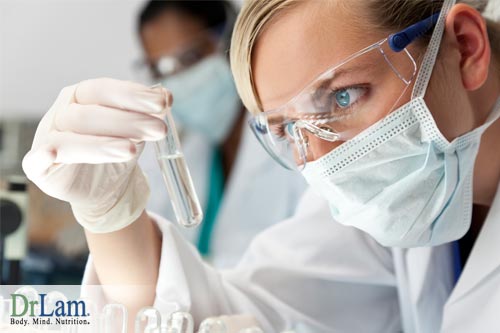 Laboratory test of T4 and T3 may be normal and classic symptoms of hypothyroid are evident with persistent low body temperature and slow ankle reflex. Alternatively, laboratory test of free T4 and free T3 may be low while TSH is normal or high. In both scenarios, thyroid replacement with T4 and T3 without first considering adrenal fortification is a common mistake and often leads to a worsening state of OAT axis imbalance. The reason is simple. Thyroid replacements tend to increase metabolic function. Raising the basal metabolic rate is akin to putting all systems of the body into overdrive at a time when the body is trying to rest by down-regulation through the many mechanisms described above. The body's survival mechanism is designed to achieve a reduction and not increased level of T4 and T3. What the body wants (to slow down) and what the medications are designed to do (to speed up) is diametrically opposed to each other.
Laboratory test of T4 and T3 may be normal and classic symptoms of hypothyroid are evident with persistent low body temperature and slow ankle reflex. Alternatively, laboratory test of free T4 and free T3 may be low while TSH is normal or high. In both scenarios, thyroid replacement with T4 and T3 without first considering adrenal fortification is a common mistake and often leads to a worsening state of OAT axis imbalance. The reason is simple. Thyroid replacements tend to increase metabolic function. Raising the basal metabolic rate is akin to putting all systems of the body into overdrive at a time when the body is trying to rest by down-regulation through the many mechanisms described above. The body's survival mechanism is designed to achieve a reduction and not increased level of T4 and T3. What the body wants (to slow down) and what the medications are designed to do (to speed up) is diametrically opposed to each other.
Administering thyroid medication in the presence of advance adrenal fatigue without concurrent attention to adrenal recovery often fails as a result. In many cases, its analogous to pouring oil onto a fire. An already weak adrenal system in a low energy state may not be able to carry the extra energy output burden. What the adrenal needs is rest, not extra work.
Thyroid medication administered under such circumstances may lead to a temporary relief of symptoms and a slight boost in energy at first. This is often short lived. Ultimately, fatigue returns, as thyroid medication further weakens pre-existing adrenal weakness and often precipitates adrenal crisis. The overall fatigue level continues to increase well beyond what the medication is trying to combat. Only by increasing medication dosage or switching to more powerful thyroid medication can worsening fatigue be avoided.
Let us look at this in more detail. While laboratory level of T4 , T3 and TSH may appear improved once thyroid replacement medication is administered, the patient clinically continues to lack of improvement and often worse over time. Physicians can be mislead by "improving" laboratory results as being "on the right track" and not attuned to possible concurrent underlying adrenal dysfunction that remains the main culprit. Unless FT4, FT3, and rT3 values are factored into the clinical picture, the true cellular delivery of thyroid medication is not known. They body's cry for action by forcing a persistent low body temperature is not attended to. The unsuspecting physician may continue to increase thyroid medication dosage in an attempt to relief unpleasant and unresolved hypothyroid symptoms. This approach seldom works long term as mentioned earlier. It unknowingly subjects the patient to worsening of overall symptoms triggered by the medication's un-intended negative effects on the adrenal glands that overshadows any of its benefit on the thyroid gland. As long as the adrenals are still functioning, it will continue to down-regulate as much as it can, blunting the body's response to thyroid medication. Over time, despite improving or stabilizing T4, T3, and TSH levels that may be considered within normal range, the patient still needs an ever larger dose of medication clinically in order to keep the symptoms at bay. The patient continues with unresolved symptoms with low body temperature that refuses to normalize while classic signs of hypothyroid persist despite medication.
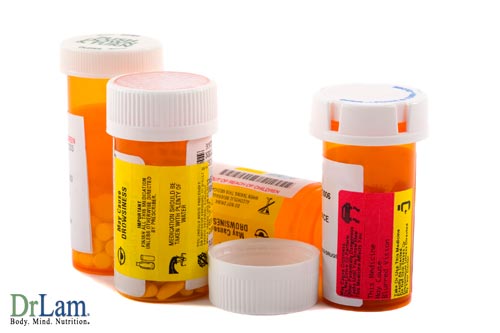 As mentioned earlier, they usually present initially to the doctor's office with high or normal TSH, low or normal T3, free T3, T4, free T4, along with persistent low body temperature. They are typically started on thyroid replacement for primary thyroids and the adrenal component is overlooked. When symptoms fail to improve, the tendency is to switch from one medication to another. Starting with synthetic T4, to T4/T3 blends, and ultimately, to potent T3. The patient is subjected to on-going trial and error as one drug after another is tried. As this is going on, the body continues to decompensates as the medication usually dispensed becomes stronger and stronger. The patient often continues to get worse despite the physician's best attempt to help. It comes as no surprise that as much as 70% of patients on thyroid replacement continues to complain of hypothyroid symptoms over time. Ultimately, the body is overloaded with thyroid medication that side effects such as heart palpitation and tremor surfaces, while the patient continues to be fatigue and sluggish. This state is known as "wired and tired".
As mentioned earlier, they usually present initially to the doctor's office with high or normal TSH, low or normal T3, free T3, T4, free T4, along with persistent low body temperature. They are typically started on thyroid replacement for primary thyroids and the adrenal component is overlooked. When symptoms fail to improve, the tendency is to switch from one medication to another. Starting with synthetic T4, to T4/T3 blends, and ultimately, to potent T3. The patient is subjected to on-going trial and error as one drug after another is tried. As this is going on, the body continues to decompensates as the medication usually dispensed becomes stronger and stronger. The patient often continues to get worse despite the physician's best attempt to help. It comes as no surprise that as much as 70% of patients on thyroid replacement continues to complain of hypothyroid symptoms over time. Ultimately, the body is overloaded with thyroid medication that side effects such as heart palpitation and tremor surfaces, while the patient continues to be fatigue and sluggish. This state is known as "wired and tired".
Those who have hypothyroid that fails to improve with thyroid replacement medication should therefore always investigate adrenal fatigue as possible etiology for the thyroid problem. Normalization of adrenal function in such cases is the key and it often leads to spontaneous resolution of hypothyroid symptoms. The faster the adrenal fatigue recovers, the faster the symptoms of hypothyroid resolve. This can happen in a matter of weeks. Those who are on thyroid replacement will invariably find that less medication is needed as the adrenal function normalizes. In fact, one can become overmedicated and thus run the risk of hyperthyroidism if thyroid medication is not reduced as adrenal fatigue recovers. This is an important yardstick and gauge of improvement of adrenal function. The credit goes to the adrenal gland and not the thyroid gland. As the adrenal improves, the need for down-regulation subsides and thyroid function suppression is lifted, leading to normalization of thyroid function. For those pursuing thyroid recovery by way of adrenal fortification first, it comes as no surprise to see the body regaining energy without increasing thyroid medication after years of relying on such replacement. In fact, thyroid replacement may not be necessary and can be tapered off totally over time as adrenal function normalizes.
It is important to note that laboratory tests of thyroid function during this adrenal focused thyroid recovery strategy, however, will continue to show low thyroid function for some time due to a lagging effect. TSH may continue to be high and out of normal range, while free T3 and free T4 continue to be low. This lagging effect can last for months. However, as the adrenal recovers, the patient clinically improves, with rising body temperature back to normal, increased energy, reduced need for thyroid medications, and improved weight management. Conventional physicians not trained to recognize this adrenal-thyroid connection are pleasantly surprised clinically to see the patient improving despite "abnormal" laboratory studies, but not knowing why. The key, of course, lies in the adrenal function.
 While it is important to factor in adrenal support as a primary focus in those with concurrent adrenal and thyroid dysfunction, it is important not to abruptly discontinue any thyroid medications (and other natural compounds that have may have stimulatory effects such as herbs and glandular's) without professional guidance. Abrupt termination may need to very unpleasant and intolerable withdrawal symptoms. In rare cases, adrenal crisis may be precipitated. The best clinical strategy is to focus on nurturing the adrenals and let the thyroid function improves on its own.
While it is important to factor in adrenal support as a primary focus in those with concurrent adrenal and thyroid dysfunction, it is important not to abruptly discontinue any thyroid medications (and other natural compounds that have may have stimulatory effects such as herbs and glandular's) without professional guidance. Abrupt termination may need to very unpleasant and intolerable withdrawal symptoms. In rare cases, adrenal crisis may be precipitated. The best clinical strategy is to focus on nurturing the adrenals and let the thyroid function improves on its own.
On the flip side, weak adrenals and thyroid, when present concurrently and not attended to properly, form an adverse reinforcing vicious downward spiral of dysfunction. Those requiring an ever larger dose of thyroid medication to keep fatigue away may end up dependent on heavy and strong thyroid medication, but have to suffer side-effect symptoms of toxic thyroid (such as heart palpitation) as the dose is increased. They are "wired and tired" as mentioned earlier, with constant fatigue, unable to fall asleep, and anxiety throughout the day. Internally, the adrenals continue to weaken as the stimulatory properties of thyroid medication is negated by continued overwhelming rejection by the adrenal gland , resulting in a body that continues to be down-regulated to conserve energy. This is the worse of both worlds. it happens too frequently and go unnoticed. Clinicians and patients alike are baffled with what seems to be clinical contradictions - improving laboratory TSH levels (as a result of increased medications) or high TSH levels that refuses to come down, rising need of thyroid medication to maintain energy, and worsening adrenal fatigue with continued low basal body temperature, metabolic imbalances, weight gain, and increased sluggishness.
Conventionally trained physician often jumped too quickly to administer thyroid medication prior to complete investigation of the root cause. This is often a failed strategy over time if the adrenal glands are dysfunctional as well but not attended to concurrently.
Before you embark on any thyroid treatment, please consult a knowledgeable physician to ascertain if your symptoms of low thyroid function is primary or secondary. Even standard primary hypothyroid diagnosis such as Hashimoto's Thyroiditis may be triggered by secondary conditions such as weak adrenals. Laboratory studies alone must be complemented with a detail history in order to have an accurate diagnosis. Over-reliance on laboratory test alone often can be misleading and confusing.
The treatment of secondary hypothyroid is focused on the adrenals and not on the thyroid gland.
The traditional standard treatment for primary hypothyroidism, on the other hand, needs to focus on the thyroid gland itself. For decades, the standard approach is synthetic T4 hormone levothyroxine, such as Levoxyl and Synthroid.
Alternative physicians prefer Amour Thyroid that contain natural thyroid hormones. Natural hormones also have T1 and T2 in addition to T3 and T4. Armour thyroid is a natural desiccated thyroid. It was the only available treatment for hypothyroid for some 50 years. Because of concern about their variable potency, these extracts have been considered obsolete for some time by all but a few natural prescribers.
 Armour thyroid needs to be taken twice a day to provide the adequate and consistent blood level of T3, which is shorter than that of T4. The common starting dose is 90 mg cut in half and taken one half after dinner and the other half after breakfast. Repeat blood test should be performed after one month and dosage adjusted accordingly to maintain TSH under 0.5. Free T3 and Free T4 should be maintained above the median but below the upper end of the laboratory normal reference range.
Armour thyroid needs to be taken twice a day to provide the adequate and consistent blood level of T3, which is shorter than that of T4. The common starting dose is 90 mg cut in half and taken one half after dinner and the other half after breakfast. Repeat blood test should be performed after one month and dosage adjusted accordingly to maintain TSH under 0.5. Free T3 and Free T4 should be maintained above the median but below the upper end of the laboratory normal reference range.
Optimum FT3 and FT4 anti-aging range for healthy young adults is towards the top end of normal range, while for the elderly is towards the middle of normal range. Once TSH, free T3 and free T4 targets are reached, annual checkup is warranted. Overweight and thyroid resistant patients might need to have their dosage increased.
While synthetic thyroid hormone made in the laboratory by drug companies usually contain T3 (Cytomel) and T4 (levothyroxine) or combinations (Thyrolar) of these two. Patients with hypothyroid show greater improvements in mood and brain function if they receive treatment Armour thyroid rather than Synthroid (thyroxin). Research reported in the New England Journal of Medicine in February of 1999 found that a majority of patients, however, might feel better on a combination of hormones such as combination of T3 and T4 instead of single T4 alone.
Those that do not wish to take thyroid replacement may consider non-commercially harvested seaweeds as the best source of organically bound iodine. 5 grams a day is needed, or about 1 ounce per week. A pound would last about two months. If you cannot get good seaweed, consider kelp supplement as alternative.
If you are on Synthroid (T4), chances are your Free T4 is at or above the high end of normal range and your Free T3 is below. You may wish to add 5 - 12.5 mg Cytomel (pure T3) after breakfast and after dinner rather than Armour thyroid or Thyrolar (synthetic T4/T3 combination).
hypothyroid is one of the most under-diagnosed diseases of the aging process. Traditional laboratory tests are outdated and highly insensitive. Proper diagnosis of thyroid disease requires a careful history and physical examination, accompanied by laboratory studies such as TSH, Free T3 and Free T4. The use of newer and more sensitive laboratory ranges is critical in the proper interpretation of these test. Most patients requiring treatment will do well on natural thyroid replacement.
The thyroid, adrenal, and ovarian axis requires intricate balance all the time. Factors that upset this balance, including female hormonal imbalance, excess intake of estrogen-like compounds such as soy, and adrenal stress can cause hypothyroidism.
Treatment of thyroid diseases must take into consideration the other the hormonal systems, including rebalancing of female hormones with estrogen and progesterone, and modulation of adrenal function with natural hormones such as pregnenolone and DHEA.
